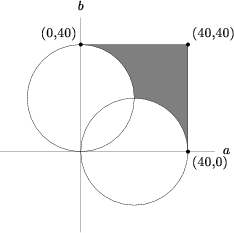Difference between revisions of "1992 AIME Problems/Problem 10"
(Undo revision 71027 by Starwars123 (talk)) |
|||
| Line 1: | Line 1: | ||
== Problem == | == Problem == | ||
Consider the region <math>A</math> in the complex plane that consists of all points <math>z</math> such that both <math>\frac{z}{40}</math> and <math>\frac{40}{\overline{z}}</math> have real and imaginary parts between <math>0</math> and <math>1</math>, inclusive. What is the integer that is nearest the area of <math>A</math>? | Consider the region <math>A</math> in the complex plane that consists of all points <math>z</math> such that both <math>\frac{z}{40}</math> and <math>\frac{40}{\overline{z}}</math> have real and imaginary parts between <math>0</math> and <math>1</math>, inclusive. What is the integer that is nearest the area of <math>A</math>? | ||
| − | |||
== Solution == | == Solution == | ||
| − | Let < | + | Let <math>z=a+bi \implies \frac{z}{40}=\frac{a}{40}+\frac{b}{40}i</math>. Since <math>0\leq \frac{a}{40},\frac{b}{40}\leq 1</math> we have the inequality <cmath>0\leq a,b \leq 40</cmath>which is a square of side length <math>40</math>. |
| − | Also, < | + | Also, <math>\frac{40}{\overline{z}}=\frac{40}{a-bi}=\frac{40a}{a^2+b^2}+\frac{40b}{a^2+b^2}i</math> so we have <math>0\leq a,b \leq \frac{a^2+b^2}{40}</math>, which leads to:<cmath>(a-20)^2+b^2\geq 20^2</cmath> |
<cmath>a^2+(b-20)^2\geq 20^2</cmath> | <cmath>a^2+(b-20)^2\geq 20^2</cmath> | ||
| Line 13: | Line 12: | ||
<center>[[Image:AIME_1992_Solution_10.png]]</center> | <center>[[Image:AIME_1992_Solution_10.png]]</center> | ||
| − | We want the area outside the two circles but inside the square. Doing a little geometry, the area of the intersection of those three graphs is < | + | We want the area outside the two circles but inside the square. Doing a little geometry, the area of the intersection of those three graphs is <math>40^2-\frac{40^2}{4}-\frac{1}{2}\pi 20^2\approx 571.68</math> |
| − | < | + | <math>\boxed{572}</math> |
| + | == See also == | ||
| + | {{AIME box|year=1992|num-b=9|num-a=11}} | ||
| + | |||
| + | [[Category:Intermediate Algebra Problems]] | ||
| + | [[Category:Intermediate Geometry Problems]] | ||
| + | {{MAA Notice}} | ||
Revision as of 12:39, 8 July 2015
Problem
Consider the region ![]() in the complex plane that consists of all points
in the complex plane that consists of all points ![]() such that both
such that both ![]() and
and ![]() have real and imaginary parts between
have real and imaginary parts between ![]() and
and ![]() , inclusive. What is the integer that is nearest the area of
, inclusive. What is the integer that is nearest the area of ![]() ?
?
Solution
Let ![]() . Since
. Since ![]() we have the inequality
we have the inequality ![]() which is a square of side length
which is a square of side length ![]() .
.
Also, ![]() so we have
so we have ![]() , which leads to:
, which leads to:![]()
![]()
We graph them:

We want the area outside the two circles but inside the square. Doing a little geometry, the area of the intersection of those three graphs is ![]()
![]()
See also
| 1992 AIME (Problems • Answer Key • Resources) | ||
| Preceded by Problem 9 |
Followed by Problem 11 | |
| 1 • 2 • 3 • 4 • 5 • 6 • 7 • 8 • 9 • 10 • 11 • 12 • 13 • 14 • 15 | ||
| All AIME Problems and Solutions | ||
The problems on this page are copyrighted by the Mathematical Association of America's American Mathematics Competitions. 









